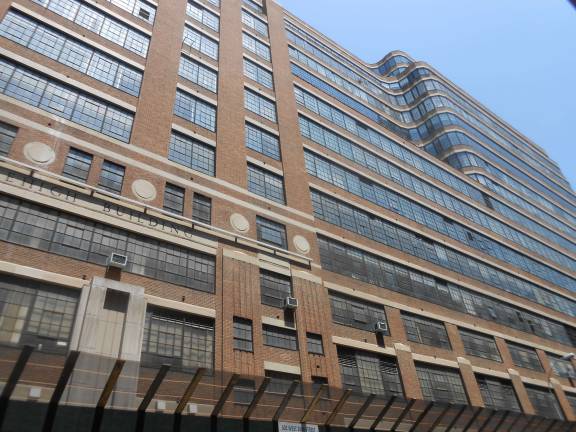CHELSEA’S MARVEL OF INNOVATION

Motorists cruising on the West Side Highway, and joggers and cyclists in Hudson River Park, may well be captivated by a striking brown-brick International-Style Art Deco structure in northwest Chelsea. The building, known as the Starrett-Lehigh Building, takes up an entire square block and has rounded corners typical of the 1930s architecture. Its brown brick alternates with uninterrupted horizontal bands of floor-to-ceiling windows.
The block-wide and -long building, at 601 West 26th St., is basically a commercial, industrial and warehouse building. It’s been a New York City landmark since 1986.
To appreciate the building, one must go back to the era in which it was built, 1930-31. In those days, private railroads transported freight into the city, but since there was (and still is) no freight tunnel under the Hudson River, freight cars were de-coupled at the Jersey piers, ferried across the river on barges, then reconnected at huge freight yards near the Manhattan waterfront where the goods were unloaded.
Among these railroads were the Baltimore & Ohio, the Pennsylvania Railroad, the Erie Railroad — and the Lehigh Valley. The Starrett-Lehigh Building, built over the railroad’s freight yard, was a collaboration between the railroad and the Starrett real-estate corporation. When William Starrett (whose company was also the general contractor on the Empire State Building) died in 1932, the railroad bought the building outright.
Part of the genius of the Starrett-Lehigh Building was the way goods were delivered right to the industrial and warehouse tenants. Freight cars were transferred onto special electric trucks, which in turn fit into huge 30-foot elevators. They were delivered straight to the customers on the upper floors. Regular motor trucks could use these elevators, too. Early photos of the building are part of a masterful exhibit on the Starrett-Lehigh Building’s ground floor.
The architecture community was impressed with the building and it was included in the International Exhibition of Modern Architecture, sponsored by Museum of Modern Art in 1932. The architects were Russell G. Cory, Walter M. Cory and Yasuo Matsui.
The building had trouble breaking even at first. This was due in part to the fact that another freight terminal building in Chelsea — the Port Authority Building at 111 Eighth Ave., now the Google Building — was under construction at the time, and it offered substantially cheaper rates.
Still, quite a number of firms occupied the Starrett-Lehigh Building. In the early days, tenants included the Wheeling Tire Company, the Standard Pressed Steel Co., famed architect-inventor Buckminster Fuller’s workshop and the Il Duce Wine Company (which presumably changed its name before World War II).
By the mid-1960s, several textile and garment manufacturing firms had moved into the building, which was now owned by real estate mogul Jacob Freidus.
New technology also affected the building. Rail freight had been declining since World War II in favor of truck traffic. In 1966, the Lehigh Valley Railroad ripped out the tracks and abandoned its railyard under the building. Thereafter, all deliveries were made by truck.
The building eventually suffered because of the downturn of manufacturing in Manhattan. The building went into foreclosure and was sold to hotel magnate Harry Helmsley. At the time, it was 40 percent vacant.
In 1998, the Helmsley organization, which was by that time headed by Leona Helmsley, the “Queen of Mean,” sold the building again. By then, tenants of a different kind were moving in — fashion and art-related businesses. Typical of these tenants were high-end fashion photographer Stephen Hellerstein and the TDF Costume Collection, which contains more than 80,000 outfits from Broadway, off-Broadway, film, opera and regional productions. (Hellerstein and TDF are now in Red Hook and Astoria, respectively.)
Today, the Starrett-Lehigh Building is owned by RXR Realty. Among its tenants are Martha Stewart Living Omnimedia, design studio Diller Scofidio + Renfro, the Mcgarrybowen advertising agency, Club Monaco of Ralph Lauren Corporation and Tommy Hilfiger USA.
These days, a choice of gourmet food trucks can be found in the truck bays on select floors or at curbside, according to the building’s website. The truck elevators carry these eateries-on-wheels to the upper floors. The Starrett-Lehigh Building is once again hip and trendy, with a 21st century flavor.